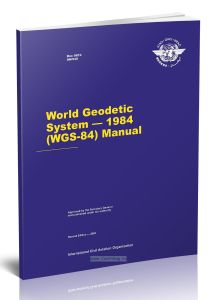- Артикул:00-01068970
- Обложка: Мягкая обложка
- Издательство: ИКАО (все книги издательства)
- Страниц: 136
- Год: 2002
- Вес: 350 г
World Geodetic System - 1984 (WGS-84) Manual/Всемирная система геодезических параметров Земли 1984 г. Руководство
Книга на английском языке.
The Council of the International Civil Aviation Organization (ICAO), at the thirteenth meeting of its 126th Session on 3 March 1989, approved Recommendation 3.2/1 of the fourth meeting of the Special Committee on Future Air Navigation Systems (FANS/4) concerning the adoption of the World Geodetic System - 1984 (WGS-84) as the standard geodetic reference system for future navigation with respect to international civil aviation.
The purpose of this manual is to furnish guidance on the provision of geographic coordinates and vertical component values referenced to the WGS-84 datum in order to assist States in the uniform implementation of the SARPs on WGS-84.
Contents
Chapter 1. Introduction
1.1 Effects of using differing coordinate reference systems in aviation
1.2 Magnitude of the problem
1.3 Navigational implications
1.4 Solution to the problem
Figures for Chapter 1
Chapter 2. Accuracy, Resolution and Integrity of Aeronautical Data
2.1 General
2.2 Type and classification of positional data
2.3 Source of raw aeronautical data
2.4 Accuracy requirements
2.5 Resolution requirements
2.6 Integrity requirements
Tables for Chapter 2
Chapter 3. The Global WGS-84 Coordinate System
3.1 Definition of the WGS-84 coordinate system
3.2 Realization of the WGS-84 coordinate system
3.3 Accuracy of WGS-84 coordinates
Figures for Chapter 3
Chapter 4. A guide to obtain WGS-84 coordinates
4.1 General
4.2 Scenario 1: Coordinates in a local reference frame are available
4.3 Scenario 2: Coordinates of the required accuracy are not available
4.4 Scenario 3: Digitized coordinates from maps are available
Figures for Chapter 4
Chapter 5. Surveying guidance
5.1 Introduction
5.2 General specifications
5.3 Survey requirements for aerodrome/heliport-related navigation elements
5.4 Aerodrome/heliport survey report requirements
5.5 Survey requirements for navigation aids
5.6 En-route survey report requirements
5.7 Use of software
5.8 Digital format for the delivery of survey data
Attachment A to Chapter 5. Monumentation
1. General
2. Numbering system for survey markers
Figures for Attachment A
Attachment B to Chapter 5. Description of geographical positions
Figures for Attachment B
Attachment C to Chapter 5. Survey reports
1. Geodetic connection
2. Aerodrome/heliport survey
3. En-route survey
Attachment D to Chapter 5. Computation of threshold coordinates
Chapter 6. Quality assurance
6.1 Quality definitions
6.2 Quality assurance (QA)
Figures for Chapter 6
Chapter 7. Deliverables
7.1 Survey reporting requirements
7.2 Basic reporting structure
7.3 Formats, standard algorithms and working practices
Figures for Chapter 7
Appendix A. The Global Positioning System (GPS)
Figures for Appendix A
Appendix B. Principles of geodesy
Figures for Appendix B
Appendix C. The International Terrestrial Reference System (ITRS)
Appendix D. Datum transformation formulae
Figure for Appendix D
Appendix E. Surveying and photogrammetric methods
Figures for Appendix E
Appendix F. Map projections
Appendix G. Sample questionnaire
Bibliography
Рекомендуем




